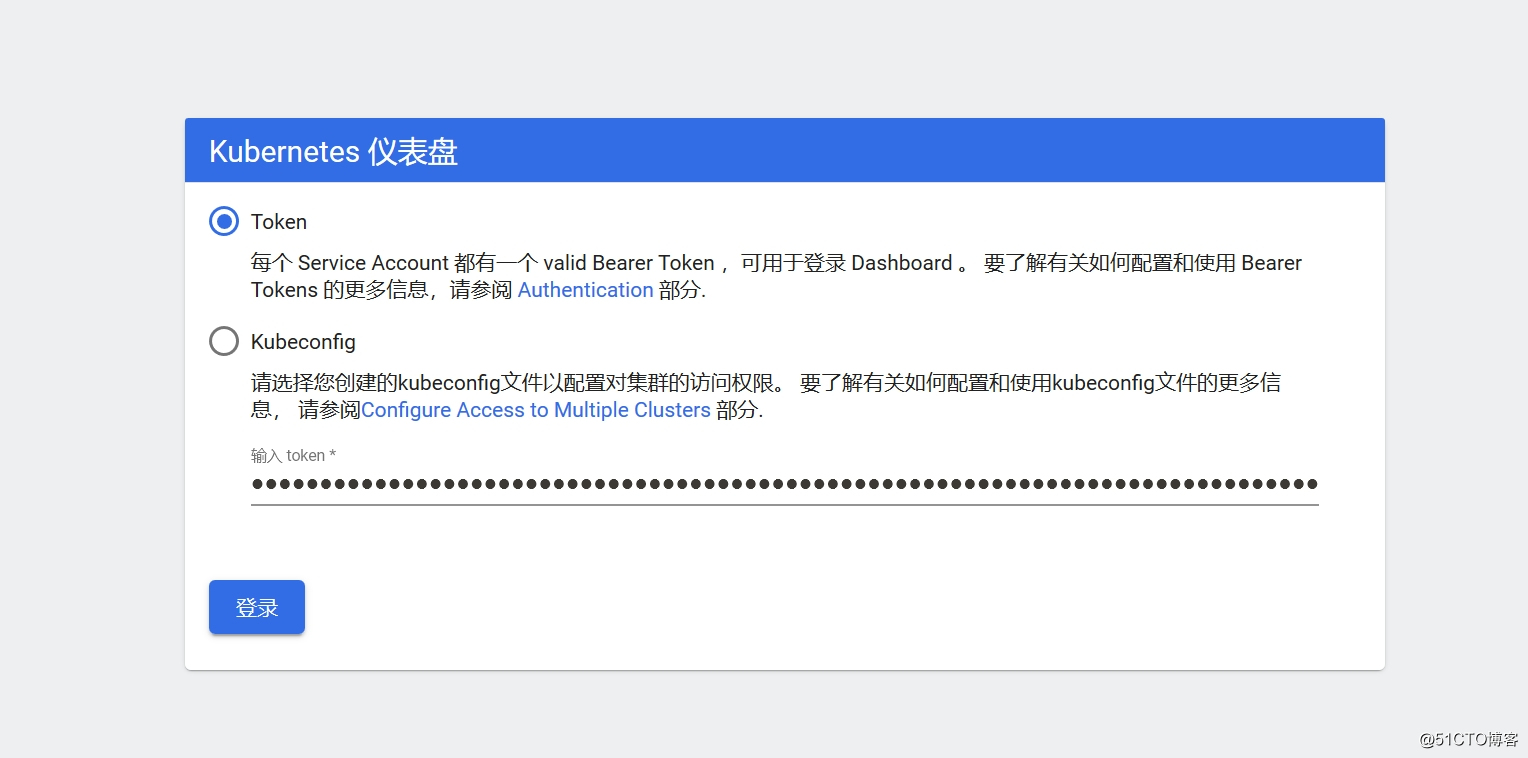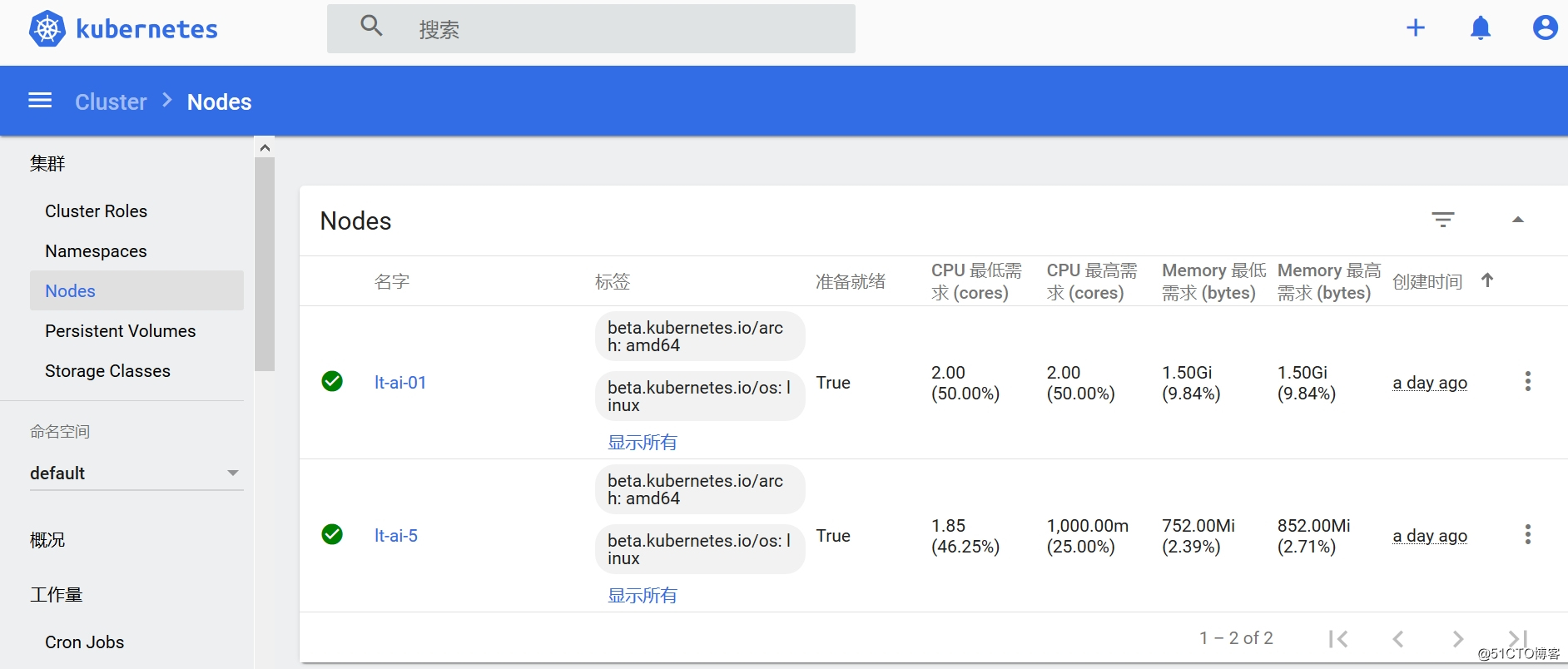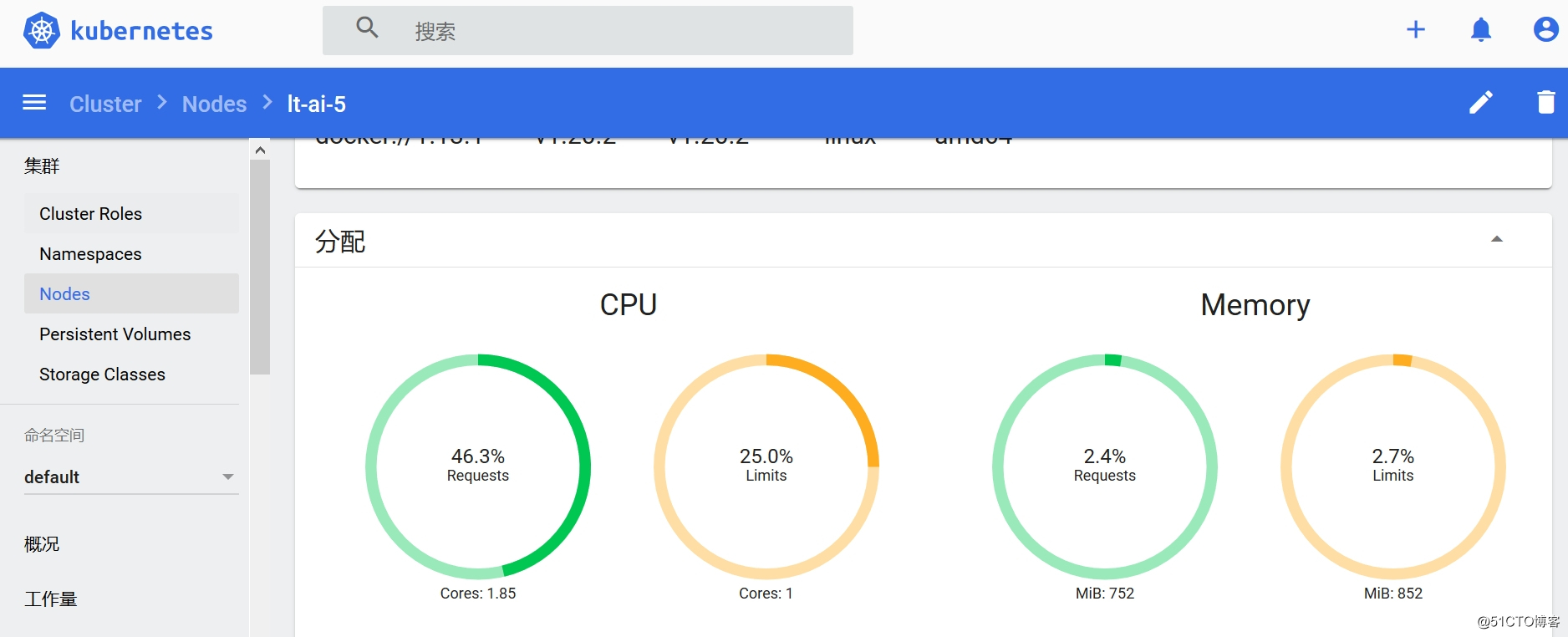1- 环境说明
| 主机名 | IP | 操作系统 | 角色 | 安装软件 |
| master | 192.168.123.212 | CentOS 8 | 管理节点 | docker |
| node1 | 192.168.123.211 | CentOS 8 | 工作节点 | docker |
| node2 | 192.168.123.210 | CentOS 8 | 工作节点 | docker |
2- 准备环境【所有节点】
一键脚本初始化环境 curl https://files-cdn.cnblogs.com/files/lemanlai/init_k8s_os_env.sh|bash
2.1- 初始化
#关闭防火墙和selinux
systemctl stop firewalld
systemctl disable firewalld
setenforce 0
sed -i.bak 's/SELINUX=enforcing/SELINUX=disabled/' /etc/selinux/config
## 关闭swap分区
swapoff -a
sed -i.bak '/ swap / s/^\(.*\)$/#\1/g' /etc/fstab
#配置清华源
rm -rf /etc/yum.repos.d/*
curl -o /etc/yum.repos.d/CentOS-Base.repo https://files-cdn.cnblogs.com/files/lemanlai/CentOS-7.repo.sh
curl -o /etc/pki/rpm-gpg/RPM-GPG-KEY-7 https://mirror.tuna.tsinghua.edu.cn/centos/7/os/x86_64/RPM-GPG-KEY-CentOS-7
yum install epel-release -y
curl -o /etc/yum.repos.d/docker-ce.repo https://files-cdn.cnblogs.com/files/lemanlai/docker-ce.repo.sh
yum clean all
yum makecache fast#或者使用阿里源curl http://mirrors.aliyun.com/repo/Centos-7.repo > /etc/yum.repos.d/CentOS-Base.repo
curl http://mirrors.aliyun.com/repo/epel-7.repo > /etc/yum.repos.d/epel.repo
curl -o /etc/yum.repos.d/docker-ce.repo https://files-cdn.cnblogs.com/files/lemanlai/docker-ce.repo.sh
yum clean all
yum makecache fast2.2- docker-ce 安装
yum remove docker docker-common docker-selinux docker-engine -y #如果你之前安装过 docker,请先删掉
yum install -y yum-utils device-mapper-persistent-data lvm2 #安装一些依赖
yum -y install docker-ce
systemctl enable docker
mkdir -p /etc/docker/ #写入加速地址和使用systemd drivercat
cat << EOF > /etc/docker/daemon.json
{"registry-mirrors": ["http://f1361db2.m.daocloud.io"],"exec-opts": ["native.cgroupdriver=systemd"]}
EOF
systemctl daemon-reload
systemctl restart docker #重启服务2.3- 内核优化
##将桥接的IPv4流量传递到iptables的链
cat > /etc/sysctl.d/k8s.conf << EOF
net.bridge.bridge-nf-call-ip6tables = 1
net.bridge.bridge-nf-call-iptables = 1
net.ipv4.ip_forward = 1
EOF
sysctl --system2.4- 安装kubeadm工具
cat << EOF >/etc/yum.repos.d/kubernetes.repo
[Kubernetes]
name=Kubernetes
baseurl=https://mirrors.aliyun.com/kubernetes/yum/repos/kubernetes-el7-x86_64
enabled=1
gpgcheck=1
repo_gpgcheck=1
gpgkey=https://mirrors.aliyun.com/kubernetes/yum/doc/yum-key.gpg
https://mirrors.aliyun.com/kubernetes/yum/doc/rpm-package-key.gpg
EOF
yum clean all
yum makecache fast -y
## 查询kubeadm版本yum list|egrep 'kubeadm|kubectl|kubelet'
[root@localhost ~]# yum list|egrep 'kubeadm|kubectl|kubelet'
kubeadm.x86_64 1.20.2 Kubernetes
kubectl.x86_64 1.20.2 Kubernetes
kubelet.x86_64 1.20.2 Kubernetes
安装 yum install -y kubeadm-1.20.2 kubelet-1.20.2 kubectl-1.20.2
## 设置开机启动kubelet systemctl enable kubelet3- 开始安装
3.1- 集群初始化【master节点】
hostnamectl set-hostname master ##设置主机名#初始化和部署master节点
kubeadm init \
--apiserver-advertise-address=192.168.123.212\
--image-repository registry.aliyuncs.com/google_containers \
--kubernetes-version v1.20.2 \
--service-cidr=10.10.0.0/16 \
--pod-network-cidr=10.122.0.0/16 \- 说明:
--apiserver-advertise-address=192.168.123.212 #Master组件监听的api地址,必须能被其他节点所访问到
--image-repository registry.aliyuncs.com/google_containers #使用阿里云镜像--kubernetes-version 1.20.2
#kubernetes的版本,阿里云上还没有1.20.2版本的镜像,此次使用1.20.2 版本--service-cidr=10.10.0.0/16 ;
#services的网络范围--pod-network-cidr=10.20.0.0/16 #Pod的网络 ;
提示:部署之前先规划好网络防止后面部署出错,网络部署错误导致后面porxy等问题;- 部署过程:
[root@master ~]#
kubeadm init \
--apiserver-advertise-address=192.168.123.212\
--image-repository registry.aliyuncs.com/google_containers \
--kubernetes-version v1.20.2 \
--service-cidr=10.10.0.0/16 \
--pod-network-cidr=10.122.0.0/16 \
W0627 18:49:03.368901 19261 configset.go:202] WARNING: kubeadm cannot validate component configs for API groups [kubelet.config.k8s.io kubeproxy.config.k8s.io]
[init] Using Kubernetes version: v1.20.2
[preflight] Running pre-flight checks
[preflight] Pulling images required for setting up a Kubernetes cluster
[preflight] This might take a minute or two, depending on the speed of your internet connection
[preflight] You can also perform this action in beforehand using 'kubeadm config images pull'[kubelet-start] Writing kubelet environment file with flags to file "/var/lib/kubelet/kubeadm-flags.env"[kubelet-start] Writing kubelet configuration to file "/var/lib/kubelet/config.yaml"[kubelet-start] Starting the kubelet
[certs] Using certificateDir folder "/etc/kubernetes/pki"[certs] Generating "ca" certificate and key
[certs] Generating "apiserver" certificate and key
[certs] apiserver serving cert is signed for DNS names [master kubernetes kubernetes.default kubernetes.default.svc kubernetes.default.svc.cluster.local] and IPs [10.10.0.1 192.168.123.212]
[certs] Generating "apiserver-kubelet-client" certificate and key
[certs] Generating "front-proxy-ca" certificate and key
[certs] Generating "front-proxy-client" certificate and key
[certs] Generating "etcd/ca" certificate and key
[certs] Generating "etcd/server" certificate and key
[certs] etcd/server serving cert is signed for DNS names [master localhost] and IPs [192.168.123.212 127.0.0.1 ::1]
[certs] Generating "etcd/peer" certificate and key
[certs] etcd/peer serving cert is signed for DNS names [master localhost] and IPs [192.168.123.212 127.0.0.1 ::1]
[certs] Generating "etcd/healthcheck-client" certificate and key
[certs] Generating "apiserver-etcd-client" certificate and key
[certs] Generating "sa" key and public key
[kubeconfig] Using kubeconfig folder "/etc/kubernetes"[kubeconfig] Writing "admin.conf" kubeconfig file
[kubeconfig] Writing "kubelet.conf" kubeconfig file
[kubeconfig] Writing "controller-manager.conf" kubeconfig file
[kubeconfig] Writing "scheduler.conf" kubeconfig file
[control-plane] Using manifest folder "/etc/kubernetes/manifests"[control-plane] Creating static Pod manifest for "kube-apiserver"[control-plane] Creating static Pod manifest for "kube-controller-manager"W0627 18:51:46.378499 19261 manifests.go:225] the default kube-apiserver authorization-mode is "Node,RBAC"; using "Node,RBAC"[control-plane] Creating static Pod manifest for "kube-scheduler"W0627 18:51:46.380355 19261 manifests.go:225] the default kube-apiserver authorization-mode is "Node,RBAC"; using "Node,RBAC"[etcd] Creating static Pod manifest for local etcd in "/etc/kubernetes/manifests"[wait-control-plane] Waiting for the kubelet to boot up the control plane as static Pods from directory "/etc/kubernetes/manifests". This can take up to 4m0s
[kubelet-check] Initial timeout of 40s passed.
[apiclient] All control plane components are healthy after 80.503096 seconds
[upload-config] Storing the configuration used in ConfigMap "kubeadm-config" in the "kube-system" Namespace
[kubelet] Creating a ConfigMap "kubelet-config-1.18" in namespace kube-system with the configuration for the kubelets in the cluster
[upload-certs] Skipping phase. Please see --upload-certs
[mark-control-plane] Marking the node master as control-plane by adding the label "node-role.kubernetes.io/master=''"[mark-control-plane] Marking the node master as control-plane by adding the taints [node-role.kubernetes.io/master:NoSchedule]
[bootstrap-token] Using token: cnl2v7.9ss2f6m1ekv2dncw
[bootstrap-token] Configuring bootstrap tokens, cluster-info ConfigMap, RBAC Roles
[bootstrap-token] configured RBAC rules to allow Node Bootstrap tokens to get nodes
[bootstrap-token] configured RBAC rules to allow Node Bootstrap tokens to post CSRs in order for nodes to get long term certificate credentials
[bootstrap-token] configured RBAC rules to allow the csrapprover controller automatically approve CSRs from a Node Bootstrap Token
[bootstrap-token] configured RBAC rules to allow certificate rotation for all node client certificates in the cluster
[bootstrap-token] Creating the "cluster-info" ConfigMap in the "kube-public" namespace
[kubelet-finalize] Updating "/etc/kubernetes/kubelet.conf" to point to a rotatable kubelet client certificate and key
[addons] Applied essential addon: CoreDNS
[addons] Applied essential addon: kube-proxy
Your Kubernetes control-plane has initialized successfully!
To start using your cluster, you need to run the following as a regular user:
mkdir -p $HOME/.kube
sudo cp -i /etc/kubernetes/admin.conf $HOME/.kube/config
sudo chown $(id -u):$(id -g) $HOME/.kube/config
You should now deploy a pod network to the cluster.
Run "kubectl apply -f [podnetwork].yaml" with one of the options listed at:
https://kubernetes.io/docs/concepts/cluster-administration/addons/
Then you can join any number of worker nodes by running the following on each as root:
kubeadm join 192.168.123.212:6443 --token cnl2v7.9ss2f6m1ekv2dncw \
--discovery-token-ca-cert-hash sha256:17baabf25b24968032bbe33538f6517ced7c970bcc28494a36b923eb86bdcfa0- 创建连接集群配置文件
mkdir -p $HOME/.kube
cp -i /etc/kubernetes/admin.conf $HOME/.kube/config
chown $(id -u):$(id -g) $HOME/.kube/config- 后续worker节点加入集群就只需要执行命令
kubeadm join 192.168.123.212:6443 --token cnl2v7.9ss2f6m1ekv2dncw \
--discovery-token-ca-cert-hash sha256:17baabf25b24968032bbe33538f6517ced7c970bcc28494a36b923eb86bdcfa0- 查看集群节点
[root@master ~]# kubectl get nodes -o wide
NAME STATUS ROLES AGE VERSION INTERNAL-IP EXTERNAL-IP OS-IMAGE
master NotReady master 4m47s v1.20.2 192.168.123.212 (Core) docker://v1.20.23.2- 部署flannel
方案1:
wget https://raw.githubusercontent.com/coreos/flannel/master/Documentation/kube-flannel.yml
sed -i 's\quay.io\quay-mirror.qiniu.com\g' kube-flannel.yml #改成国内源,加速镜像下载 kubectl apply -f kube-flannel.yml
方案2:
kubectl apply -f https://docs.projectcalico.org/manifests/calico.yaml
configmap/calico-config created
customresourcedefinition.apiextensions.k8s.io/bgpconfigurations.crd.projectcalico.org created
customresourcedefinition.apiextensions.k8s.io/bgppeers.crd.projectcalico.org created
customresourcedefinition.apiextensions.k8s.io/blockaffinities.crd.projectcalico.org created
customresourcedefinition.apiextensions.k8s.io/clusterinformations.crd.projectcalico.org created
customresourcedefinition.apiextensions.k8s.io/felixconfigurations.crd.projectcalico.org created
customresourcedefinition.apiextensions.k8s.io/globalnetworkpolicies.crd.projectcalico.org created
customresourcedefinition.apiextensions.k8s.io/globalnetworksets.crd.projectcalico.org created
customresourcedefinition.apiextensions.k8s.io/hostendpoints.crd.projectcalico.org created
customresourcedefinition.apiextensions.k8s.io/ipamblocks.crd.projectcalico.org created
customresourcedefinition.apiextensions.k8s.io/ipamconfigs.crd.projectcalico.org created
customresourcedefinition.apiextensions.k8s.io/ipamhandles.crd.projectcalico.org created
customresourcedefinition.apiextensions.k8s.io/ippools.crd.projectcalico.org created
customresourcedefinition.apiextensions.k8s.io/networkpolicies.crd.projectcalico.org created
customresourcedefinition.apiextensions.k8s.io/networksets.crd.projectcalico.org created
clusterrole.rbac.authorization.k8s.io/calico-kube-controllers created
clusterrolebinding.rbac.authorization.k8s.io/calico-kube-controllers created
clusterrole.rbac.authorization.k8s.io/calico-node created
clusterrolebinding.rbac.authorization.k8s.io/calico-node created
daemonset.apps/calico-node createdserviceaccount/calico-node created
deployment.apps/calico-kube-controllers createdserviceaccount/calico-kube-controllers created部署过程:
[root@master ~]# kubectl apply -f kube-flannel.yml
podsecuritypolicy.policy/psp.flannel.unprivileged created
clusterrole.rbac.authorization.k8s.io/flannel created
clusterrolebinding.rbac.authorization.k8s.io/flannel created
serviceaccount/flannel created
configmap/kube-flannel-cfg created
daemonset.apps/kube-flannel-ds-amd64 created
daemonset.apps/kube-flannel-ds-arm64 created
daemonset.apps/kube-flannel-ds-arm created
daemonset.apps/kube-flannel-ds-ppc64le created
daemonset.apps/kube-flannel-ds-s390x created[root@master ~]# kubectl get nodes -o wide
NAME STATUS ROLES AGE VERSION INTERNAL-IP EXTERNAL-IP OS-IMAGE
master Ready master 16m v1.20.2 192.168.123.212 (Core) docker://v1.20.23.2- 加入集群【node节点】
hostnamectl set-hostname node-1##加入集群
kubeadm join 192.168.123.212:6443 --token cnl2v7.9ss2f6m1ekv2dncw \
--discovery-token-ca-cert-hash sha256:17baabf25b24968032bbe33538f6517ced7c970bcc28494a36b923eb86bdcfa0##加入过程
[root@localhost ~]# kubeadm join 192.168.123.212:6443 --token cnl2 v7.9
ss2f6m1ekv2dncw --discovery-token-ca-cert-hash sha256:17baabf25b24968032bbe33538f6517ced7c970bcc28494a36b923eb86bdcfa0W0627 20:49:40.750611 2328 join.go:346] [preflight] WARNING: JoinControlPane.controlPlane settings will be ignored when control-plane flag is not set.
[preflight] Running pre-flight checks
[WARNING IsDockerSystemdCheck]: detected "cgroupfs" as the Docker cgroup driver. The recommended driver is "systemd". Please follow the guide at https://kubernetes.io/docs/setup/cri/
[preflight] Reading configuration from the cluster...
[preflight] FYI: You can look at this config file with 'kubectl -n kube-system get cm kubeadm-config -oyaml'[kubelet-start] Downloading configuration for the kubelet from the "kubelet-config-1.18" ConfigMap in the kube-system namespace
[kubelet-start] Writing kubelet configuration to file "/var/lib/kubelet/config.yaml"[kubelet-start] Writing kubelet environment file with flags to file "/var/lib/kubelet/kubeadm-flags.env"[kubelet-start] Starting the kubelet
[kubelet-start] Waiting for the kubelet to perform the TLS Bootstrap...bash
This node has joined the cluster:
* Certificate signing request was sent to apiserver and a response was received.
* The Kubelet was informed of the new secure connection details.
Run 'kubectl get nodes' on the control-plane to see this node join the cluster.##在master执行
[root@master ~]# kubectl get nodes
NAME STATUS ROLES AGE VERSION
master Ready master 129m v1.20.2
node-1 Ready <none> 39m v1.20.2##node-1添加集群配置文件,允许node节点访问集群
[root@node-1 ~]# mkdir -p $HOME/.kube ##node节点运行#master节点
[root@master ~]# scp /etc/kubernetes/admin.conf root@192.168.123.211:/root/.kube/config
root@192.168.123.211's password:
admin.conf 100% 5451 3.9MB/s 00:00
##node节点
[root@node-1 ~]# chown $(id -u):$(id -g) $HOME/.kube/config
[root@node-1 ~]# kubectl get nodes
NAME STATUS ROLES AGE VERSION
master Ready master 136m v1.20.2
node-1 Ready <none> 46m v1.20.2
##以上看到node-1的roles没有标签
##添加node-1的role标签为node
[root@node-1 ~]# kubectl label node node-1
node-role.kubernetes.io/node=node/node-1 labeled
[root@node-1 ~]# kubectl get nodes
NAME STATUS ROLES AGE VERSION
master Ready master 139m v1.20.2
node-1 Ready node 49m v1.20.24- 部署应用
4.1- 部署 Dashboard
系统环境:
一、简介
Kubernetes 版本:1.20.1 kubernetes-dashboard 版本:v2.0.0
Kubernetes Dashboard 是 Kubernetes 集群的基于 Web 的通用 UI。它允许用户管理在群集中运行的应用程序并对其进行故障排除,以及管理群集本身。这个项目在 Github 已经有半年多不更新了,最近推出了
v2.0.0 版本,这里在 Kubernetes 中部署一下,尝试看看新版本咋样。
二、兼容性
✕ 不支持的版本范围。✓ 完全支持的版本范围。? 由于Kubernetes API版本之间的重大更改,某些功能可能无法在仪表板中正常运行。三、部署 Kubernetes Dashboard
注意:如果“kube-system”命名空间已经存在 Kubernetes-Dashboard 相关资源,请换成别的 Namespace。
完整部署文件
Github 地址:https://github.com/my-dlq/blog-example/tree/master/kubernetes/kubernetes-dashboard2.0.0-deploy
pull down相关的镜像
[root@master dashboard]# docker pull kubernetesui/dashboard:v2.0.0
v2.0.0: Pulling from kubernetesui/dashboard2a43ce254c7f:
Pull complete Digest: sha256:06868692fb9a7f2ede1a06de1b7b32afabc40ec739c1181d83b5ed3eb147ec6eStatus:
Downloaded newer image for kubernetesui/dashboard:v2.0.0docker.io/kubernetesui/dashboard:v2.0.0
[root@master kubelet-config]# docker pull kubernetesui/metrics-scraper:v1.0.4
v1.0.4: Pulling from kubernetesui/metrics-scraper07008dc53a3e:
Pull complete 1f8ea7f93b39: Pull complete 04d0e0aeff30:
Pull complete Digest: sha256:555981a24f184420f3be0c79d4efb6c948a85cfce84034f85a563f4151a81cbfStatus:
Downloaded newer image for kubernetesui/metrics-scraper:v1.0.4docker.io/kubernetesui/metrics-scraper:v1.0.41、Dashboard RBAC
创建 Dashboard RBAC 部署文件
dashboard-rbac.yaml
apiVersion: v1
kind: ServiceAccount
metadata:
labels:
k8s-app: kubernetes-dashboard
name: kubernetes-dashboard
namespace: kube-system
---
apiVersion: rbac.authorization.k8s.io/v1
kind: Role
metadata:
labels:
k8s-app: kubernetes-dashboard
name: kubernetes-dashboard
namespace: kube-system
rules:
- apiGroups: [""]
resources: ["secrets"]
resourceNames: ["kubernetes-dashboard-key-holder", "kubernetes-dashboard-certs", "kubernetes-dashboard-csrf"]
verbs: ["get", "update", "delete"]
- apiGroups: [""]
resources: ["configmaps"]
resourceNames: ["kubernetes-dashboard-settings"]
verbs: ["get", "update"]
- apiGroups: [""]
resources: ["services"]
resourceNames: ["heapster", "dashboard-metrics-scraper"]
verbs: ["proxy"]
- apiGroups: [""]
resources: ["services/proxy"]
resourceNames: ["heapster", "http:heapster:", "https:heapster:", "dashboard-metrics-scraper", "http:dashboard-metrics-scraper"]
verbs: ["get"]
---
apiVersion: rbac.authorization.k8s.io/v1
kind: ClusterRole
metadata:
labels:
k8s-app: kubernetes-dashboard
name: kubernetes-dashboard
rules:
- apiGroups: ["metrics.k8s.io"]
resources: ["pods", "nodes"]
verbs: ["get", "list", "watch"]
---
apiVersion: rbac.authorization.k8s.io/v1
kind: RoleBinding
metadata:
labels:
k8s-app: kubernetes-dashboard
name: kubernetes-dashboard
namespace: kube-system
roleRef:
apiGroup: rbac.authorization.k8s.io
kind: Role
name: kubernetes-dashboard
subjects:
- kind: ServiceAccount
name: kubernetes-dashboard
namespace: kube-system
---
apiVersion: rbac.authorization.k8s.io/v1
kind: ClusterRoleBinding
metadata:
name: kubernetes-dashboard
namespace: kube-system
roleRef:
apiGroup: rbac.authorization.k8s.io
kind: ClusterRole
name: kubernetes-dashboard
subjects:
- kind: ServiceAccount
name: kubernetes-dashboard
namespace: kube-system
部署 Dashboard RBAC
$ kubectl apply -f dashboard-rbac.yaml
2、创建 ConfigMap、Secret
创建 Dashboard Config & Secret 部署文件
dashboard-configmap-secret.yaml
apiVersion: v1
kind: Secret
metadata:
labels:
k8s-app: kubernetes-dashboard
name: kubernetes-dashboard-certs
namespace: kube-system
type: Opaque
---
apiVersion: v1
kind: Secret
metadata:
labels:
k8s-app: kubernetes-dashboard
name: kubernetes-dashboard-csrf
namespace: kube-system
type: Opaque
data:
csrf: ""
---
apiVersion: v1
kind: Secret
metadata:
labels:
k8s-app: kubernetes-dashboard
name: kubernetes-dashboard-key-holder
namespace: kube-system
type: Opaque
---
kind: ConfigMap
apiVersion: v1
metadata:
labels:
k8s-app: kubernetes-dashboard
name: kubernetes-dashboard-settings
namespace: kube-system
部署 Dashboard Config & Secret
$ kubectl apply -f dashboard-configmap-secret.yaml
3、kubernetes-dashboard
创建 Dashboard Deploy 部署文件
dashboard-deploy.yaml
## Dashboard Service
kind: Service
apiVersion: v1
metadata:
labels:
k8s-app: kubernetes-dashboard
name: kubernetes-dashboard
namespace: kube-system
spec:
type: NodePort
ports:
- port: 443
nodePort: 30001
targetPort: 8443
selector:
k8s-app: kubernetes-dashboard
---
## Dashboard Deployment
kind: Deployment
apiVersion: apps/v1
metadata:
labels:
k8s-app: kubernetes-dashboard
name: kubernetes-dashboard
namespace: kube-system
spec:
replicas: 1
revisionHistoryLimit: 10
selector:
matchLabels:
k8s-app: kubernetes-dashboard
template:
metadata:
labels:
k8s-app: kubernetes-dashboard
spec:
serviceAccountName: kubernetes-dashboard
containers:
- name: kubernetes-dashboard
image: kubernetesui/dashboard:v2.0.0
#image: registry.cn-hangzhou.aliyuncs.com/google_containers/metrics-scraper:v1.0.4
securityContext:
allowPrivilegeEscalation: false
readOnlyRootFilesystem: true
runAsUser: 1001
runAsGroup: 2001
ports:
- containerPort: 8443
protocol: TCP
args:
- --auto-generate-certificates
- --namespace=kube-system #设置为当前部署的Namespace
resources:
limits:
cpu: 1000m
memory: 512Mi
requests:
cpu: 1000m
memory: 512Mi
livenessProbe:
httpGet:
scheme: HTTPS
path: /
port: 8443
initialDelaySeconds: 30
timeoutSeconds: 30
volumeMounts:
- name: kubernetes-dashboard-certs
mountPath: /certs
- name: tmp-volume
mountPath: /tmp
- name: localtime
readOnly: true
mountPath: /etc/localtime
volumes:
- name: kubernetes-dashboard-certs
secret:
secretName: kubernetes-dashboard-certs
- name: tmp-volume
emptyDir: {}
- name: localtime
hostPath:
type: File
path: /etc/localtime
tolerations:
- key: node-role.kubernetes.io/master
effect: NoSchedule
部署 Dashboard Deploy
$ kubectl apply -f dashboard-deploy.yaml
4、创建 kubernetes-metrics-scraper
创建 Dashboard Metrics 部署文件
dashboard-metrics.yaml
## Dashboard Metrics Service
kind: Service
apiVersion: v1
metadata:
labels:
k8s-app: dashboard-metrics-scraper
name: dashboard-metrics-scraper
namespace: kube-system
spec:
ports:
- port: 8000
targetPort: 8000
selector:
k8s-app: dashboard-metrics-scraper
---
## Dashboard Metrics Deployment
kind: Deployment
apiVersion: apps/v1
metadata:
labels:
k8s-app: dashboard-metrics-scraper
name: dashboard-metrics-scraper
namespace: kube-system
spec:
replicas: 1
revisionHistoryLimit: 10
selector:
matchLabels:
k8s-app: dashboard-metrics-scraper
template:
metadata:
labels:
k8s-app: dashboard-metrics-scraper
annotations:
seccomp.security.alpha.kubernetes.io/pod: 'runtime/default'
spec:
serviceAccountName: kubernetes-dashboard
containers:
- name: dashboard-metrics-scraper
image: kubernetesui/metrics-scraper:v1.0.4
securityContext:
allowPrivilegeEscalation: false
readOnlyRootFilesystem: true
runAsUser: 1001
runAsGroup: 2001
ports:
- containerPort: 8000
protocol: TCP
resources:
limits:
cpu: 1000m
memory: 512Mi
requests:
cpu: 1000m
memory: 512Mi
livenessProbe:
httpGet:
scheme: HTTP
path: /
port: 8000
initialDelaySeconds: 30
timeoutSeconds: 30
volumeMounts:
- mountPath: /tmp
name: tmp-volume
- name: localtime
readOnly: true
mountPath: /etc/localtime
volumes:
- name: tmp-volume
emptyDir: {}
- name: localtime
hostPath:
type: File
path: /etc/localtime
nodeSelector:
"beta.kubernetes.io/os": linux
tolerations:
- key: node-role.kubernetes.io/master
effect: NoSchedule
部署 Dashboard Metrics
$ kubectl apply -f dashboard-metrics.yaml
5、创建访问的 ServiceAccount
创建一个绑定 admin 权限的 ServiceAccount,获取其 Token 用于访问看板。
创建 Dashboard ServiceAccount 部署文件
dashboard-token.yaml
kind: ClusterRoleBinding
apiVersion: rbac.authorization.k8s.io/v1
metadata:
name: admin
annotations:
rbac.authorization.kubernetes.io/autoupdate: "true"
roleRef:
kind: ClusterRole
name: cluster-admin
apiGroup: rbac.authorization.k8s.io
subjects:
- kind: ServiceAccount
name: admin
namespace: kube-system
---
apiVersion: v1
kind: ServiceAccount
metadata:
name: admin
namespace: kube-system
labels:
kubernetes.io/cluster-service: "true"
addonmanager.kubernetes.io/mode: Reconcile
部署访问的 ServiceAccount
$ kubectl apply -f dashboard-token.yaml#获取 Token
kubectl describe secret/$(kubectl get secret -n kube-system |grep admin|awk '{print $1}') -n kube-syste
token:
eyJhbGciOiJSUzI1NiIsImtpZCI6Ikp2bV9pZmNIR0xqLUxRREd3QlRzNU1pdnBkYnMxTXRlWG15alBidW0xNTAifQ.eyJpc3MiOiJrdWJ
lcm5ldGVzL3NlcnZpY2VhY2NvdW50Iiwia3ViZXJuZXRlcy5pby9zZXJ2aWNlYWNjb3VudC9uYW1lc3BhY2UiOiJrdWJlLXN5c3RlbSIsI
mt1YmVybmV0ZXMuaW8vc2VydmljZWFjY291bnQvc2VjcmV0Lm5hbWUiOiJhZG1pbi10b2tlbi1zandkdiIsImt1YmVybmV0ZXMuaW8vc2Vydml
jZWFjY291bnQvc2VydmljZS1hY2NvdW50Lm5hbWUiOiJhZG1pbiIsImt1YmVybmV0ZXMuaW8vc2VydmljZWFjY291bnQvc2VydmljZS1hY2Nvd
W50LnVpZCI6IjUxOTAxNmFkLTU3YjEtNDkzYS04ZGZiLTM2Mzg3NTIwODgwNiIsInN1YiI6InN5c3RlbTpzZXJ2aWNlYWNjb3VudDprdWJlLX
N5c3RlbTphZG1pbiJ9.I4voTZHn83jPe7apabqOtTjsBuj0uEbkgQGu1fl2tAbbpocg89NjN-DrTkyrETa7qDVp2bmXCHbIbiJU64xlfifCgN
FgO0HnWqvuMgztYnYMUpbYSRuQVumn-WCDsIxBnfK-lIbhdSGZZVS66PK4Rwlf4hQHdE_3oclzBYnoz_i11xoFaDDUhhSLxmIDuBA-HoR-n_L
JRDtJEqD7VmCTiDkUECxVpIM2oQtVb-nLxuBQg7M7rsbdWFsp5MJ7f-AdRBFgszEQaezBCt4kf0Uuakl6AC_0fDGjwEo04M12Md5Q7JOkyUNKg
Pbw0S3p8rxuw07I_LBipTIW8Sznll_wzw四、登录新版本 Dashboard 查看
本人的 Kubernetes 集群地址为”192.168.0.155”并且在 Service 中设置了 NodePort 端口为 30001 和类型为 NodePort 方式访问 Dashboard ,所以访问地址:https://192.168.0.155:30001 进入 Kubernetes Dashboard 页面,
然后输入上一步中创建的 ServiceAccount 的 Token 进入 Dashboard,可以看到新的 Dashboard。浏览器打开ip地址 https://192.168.123.212:30001

























 1281
1281











 被折叠的 条评论
为什么被折叠?
被折叠的 条评论
为什么被折叠?








